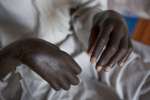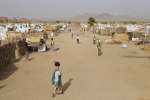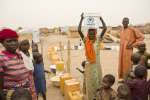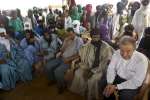57th Lecture of the Americas: "From the Cartagena Declaration to the Brazil Plan of Action: The new Frontiers of Protection in the Americas", António Guterres, UNHCR, Washington, D.C., 22 April 2015
Statements by High Commissioner, 22 April 2015
Honorable Madam Ambassador Moreno,
Excellencies,
Ladies and Gentlemen,
It is an honour for me to be here today at the Organization of American States, the oldest multilateral and inter-governmental organization in the world, to speak to you about protection in the Americas.
Let me start by saying how grateful I am to the OAS and its Member States for their commitment to the protection of the persons my Office was created to protect. In particular, the Latin American region is an example for the rest of the world in the solidarity it shows with people fleeing violence and persecution. Several OAS Member States have some of the best, most progressive asylum systems in the world, and a strong tradition of protection that has few parallels elsewhere.
This continent has provided generous asylum to refugees from the region as well as from other parts of the world and although only 8% of the world's refugees are hosted in the Americas, the OAS region receives 80 per cent of all resettled refugees globally. It is one of the largest contributors to the refugee cause and plays an important leadership role in humanitarian issues.
This commitment to the highest standards of humanity and solidarity goes back to the very foundation of the OAS. Already starting in 1965 Member States discussed the adoption of a regional convention on refugees, acceded to international refugee instruments, and adopted robust legal and institutional frameworks for protection. The Cartagena Declaration on Refugees of 1984, adopted in response to the Central American refugee crises, was a true landmark – both for regional and global refugee protection. It not only extended the refugee definition, but provided a true compendium of international protection that covers the entire cycle of forced displacement. It put emphasis on preserving humanitarian space, granting asylum, strengthening legal and institutional frameworks and achieving durable solutions. And even more significantly, it pioneered a holistic view of refugee, human rights and humanitarian protection combined, underscoring the critical importance of regional cooperation among governments, international organizations, and civil society.
Ever since then, "Cartagena" has become a humanitarian brand name that reflects the dedication of the OAS region to continually innovate and broaden the scope and quality of international protection – to the extent that, today, all the "new frontiers" which protection must address are being tackled here in this region.
Ten years after Cartagena, a new phenomenon was on the rise: internal forced displacement, particularly in the Andean region. The 1994 San Jose Declaration on Refugees and Internally Displaced Persons therefore focused on the importance of preserving humanitarian space, addressing root causes of forced displacement, and the humanitarian needs of internally displaced persons.
In 2004, when commemorating the 20th Anniversary of Cartagena, Latin American States and a few Caribbean countries adopted the Mexico Declaration and a ten-year Plan of Action. This included for the first time three innovative programmes building on regional solidarity and south-south cooperation: Borders of solidarity, Cities of solidarity and solidarity resettlement.
And finally, last December at the Cartagena+30 anniversary event, countries in the Americas came together to reflect about the contemporary challenges of displacement and protection in the region. They adopted the Brazil Declaration and Plan of Action, which aims to address some of the "new frontiers" I mentioned earlier: forced displacement generated by transnational organized crime; mixed migration and refugee protection, including protection at sea; comprehensive durable solutions including migratory and labour alternatives; statelessness; regional cooperation and responsibility sharing mechanisms; as well as contemporary global topics, such as displacement generated by climate change and natural disasters.
As we look at this rich tradition of refugee protection in the Americas, it is clear this region embodies some essential values that are of significance far beyond the limits of the continent. These values include generosity, solidarity, inclusiveness, innovation, pragmatism and openness to new challenges.
Today, a multiplication of new conflicts and a failure to resolve old crises have caused more people to become forcibly displaced worldwide than at any other time since the Second World War. Displacement not only continues to grow but is becoming increasingly complex, and there are many places where refugees struggle to find safety. Look at the tragic events in the Mediterranean these past few days. In times like these, the values that characterize refugee protection in the Americas set a global example.
Against this background, the Brazil Declaration and Plan of Action draw out several of the core priorities for international protection in this region, many of which are also relevant beyond its borders.
First, the need for collective engagement to respond to displacement as a result of transnational organized crime and other forms of violence that are not yet reflected in existing protection frameworks. Non-state actors, such as maras, pandillas and drug cartels generate significant forced displacement mainly in the Northern Triangle of Central America. The surge in unaccompanied children and families arriving at the southern US border forms part of this new regional context. A significant number of them have valid international protection claims – fleeing from forced recruitment, harassment, sexual violence and abuse, and extortion at the hands of non-state actors.
These complex mixed migratory movements highlight a need we see today in several regions of the world. We must strengthen protection systems in countries of origin, transit and final destination, rather than narrowly focusing on deterrence, which will never be the answer when people are fleeing for their bare lives. In countries of origin, this means adopting adequate public policies, establishing prevention and early warning mechanisms, capacitating states to address the needs of those at risk, and making communities part of the solution. Further afield, it means reinforcing reception arrangements in border areas in order to identify people in need of international protection. Other Latin and North American countries can contribute to stronger protection systems in Central America, sharing experiences and good examples on how to address complex displacement situations.
Secondly, we must work together to strengthen the protection response in the Caribbean. In a region mostly affected by mixed migration flows, with extended maritime borders where protection at sea is a key feature, and confronted with limited human and financial resources, governments of the affected states as well as the international community must support all efforts that will save lives at sea and provide adequate protection to those most at risk. The Brazil Declaration and Plan of Action calls for enhanced regional solidarity with the Caribbean to sustain and accompany this process.
Thirdly, I cannot overemphasize the importance of comprehensive, complementary and sustainable solutions, which combine voluntary repatriation, local integration, and resettlement into a holistic strategy. But contemporary challenges also mean we have to start going beyond traditional solutions. Here too, Latin America is a pioneer, exploring creative ways to apply regional migration and labour mobility schemes to benefit refugees, for example in the MERCOSUR region. I very much hope that this innovative regional arrangement can be extended to other American countries, and eventually benefit all refugees in the region, regardless of their nationality.
Resettlement is another essential part of responsibility sharing mechanisms. Several OAS Member States have responded to my call to provide resettlement or other forms of admission for Syrian refugees – Uruguay through its resettlement programme and Argentina and Brazil offering humanitarian visas are new examples to quote, and I hope other countries will soon follow this commendable example.
Lastly, the Americas have a key role to play in the global fight against statelessness, as reflected in what was agreed in Brazil. Many countries in this region are already champions in our campaign to eradicate statelessness within the next decade, as reflected in the high number of accessions to the 1954 Convention relating to the Status of Stateless Persons and the 1961 Convention on the Reduction of Statelessness. Several governments are making efforts to prevent statelessness by reviewing their nationality laws to ensure they are aligned with international standards. One especially important aspect of this is the need to end gender discrimination in nationality laws, for example by ensuring that women can pass on their nationality to their children on the same basis as men everywhere. I also hope OAS member states will work towards establishing statelessness determination procedures in the future, which so far exist in only one country in the region and in very few around the world.
Finally, as regards the resolution of major situations of statelessness, I welcome the legal orientation recently provided by the Inter-American Court of Human Rights. Facilitating the naturalization of stateless persons, and restoring nationality where people have been deprived of it, are the best solutions in these situations.
Ladies and Gentlemen, dear friends,
The Plan of Action agreed in Brazil offers us a strategic framework to move forward the protection and solutions agenda for some of the most vulnerable people in the Americas. Let's seize this opportunity. Let's keep the spirit of Cartagena alive, and let this region expand the global example it is already setting.
What do we need to achieve this? First, a real commitment by North American, Latin American, and Caribbean countries to the implementation of the Brazil agreement. Second, effective and sustainable assistance from North America, and other regions, to accompany the process in the spirit of regional solidarity and responsibility-sharing. Third, there is a need for stronger partnerships, and I hope the OAS and the other regional and sub-regional entities in the Americas will include the components of the Brazil Plan of Action in their agendas and priorities.
The "Cartagena spirit", as we have seen over these past 30 years, is growing stronger with every anniversary, and is a significant positive force in broadening and strengthening the leadership role of the Americas. I hope, therefore, that this spirit will move northwards, and that we could see North America becoming an integral part of the Cartagena+40 process in 2024.
Thank you very much.








































